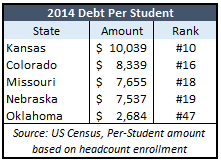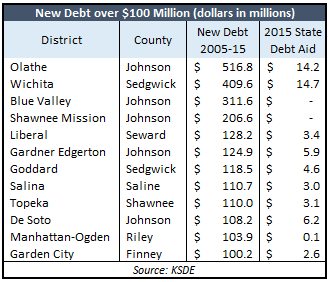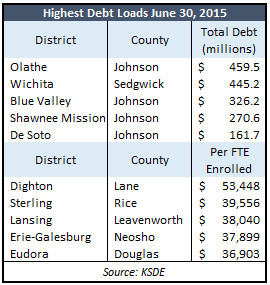Editor’s Note: The original version of this post was based on published Census data. KPI subsequently discovered that Census inadvertently excluded USD 512 Shawnee Mission data from their reported totals for 2014; KSDE and Census officials confirmed our finding. Census will not republish correct data until 2015 data is released but did provide us with revised Kansas data for Tables 1, 8 and 19 of their report; this post now reflects that updated information.
Data provided by the Kansas Department of Education shows school districts loaded up on a lot of new debt over last ten years.
- $4.8 billion in new debt was issued by 143 districts.
- Debt Service payments totaled $4.1 billion.
- Bonded indebtedness increased $2.2 billion or 71%.
- Debt Service payments jumped 72%, from $286 million in 2005 to $493 million in 2015.
- Total bonded indebtedness as of June 30, 2015 was $5.4 billion spread across 183 districts; 103 districts have no bonded indebtedness.
2014 Census data (the most current) shows Kansas had the 10th highest per-pupil indebtedness in the nation at $10,039 on a headcount basis. Kansas was also the highest among neighboring states.
the 10th highest per-pupil indebtedness in the nation at $10,039 on a headcount basis. Kansas was also the highest among neighboring states.
A dozen school districts issued more than $100 million in new bonded indebtedness over the last ten years. USD 233 Olathe tops the list at $516.8  million (and just passed another $156 million bond issue), with Wichita and Blue Valley rounding out the quarter-billion-dollar club. Much of the new debt is subsidized by citizens outside the issuing district, which has a direct impact on state aid available for educating students. Ten of the top 12 debt issuers are subsidized by other Kansans. The Division of Budget estimates that Bond & Interest aid will be $181 million in FY 2017, which would be nearly triple the $63.7 million spent in FY 2007. To put that in perspective, had Bond & Interest aid remained steady over that period, $527 million more could have been available to fund Instruction.
million (and just passed another $156 million bond issue), with Wichita and Blue Valley rounding out the quarter-billion-dollar club. Much of the new debt is subsidized by citizens outside the issuing district, which has a direct impact on state aid available for educating students. Ten of the top 12 debt issuers are subsidized by other Kansans. The Division of Budget estimates that Bond & Interest aid will be $181 million in FY 2017, which would be nearly triple the $63.7 million spent in FY 2007. To put that in perspective, had Bond & Interest aid remained steady over that period, $527 million more could have been available to fund Instruction.
School districts heavily promote the fact that citizens outside the district will have to pick a portion of the cost. USD 259 Wichita, for example, even had campaign signs promoting that 25% of their debt would be paid by other people. Districts say the State picks up the tab, but that just means that someone else has to be taxed more to pay for it. It’s a modern day version of taxation without representation.
USD 233 Olathe also has the largest amount of bonded indebtedness at $459.5 million and gets the second-largest distribution of debt subsidization by non-district residents ($14.2 million in 2015). New debt issued by Olathe over the last ten years is a little higher than total current indebtedness because districts pay off or partially pay down old bond issues before issuing new debt.
The ‘pitch’ to take on new debt is often akin to credit card ads that promise to keep payments low; districts say ‘voting for this won’t raise your mill rate’ without disclosing that taxes would decline if the new bond issues is voted down – because old debt has been paid off and the tax to pay for it would go away. Perhaps new debt ballots should disclose the amount by which taxes would change with a ‘yes’ or ‘no’ vote. On a debt-per-student basis, USD 482 Dighton tops the list owing $53,448 for each of their 232 students. Olathe, by comparison, owes $16,648 for each of their 27,601 students. The average amount owed per-student for the districts with debt last year was $11,589. (These calculations are based on full time equivalent employment rather than the headcount measurement used by Census.)
card ads that promise to keep payments low; districts say ‘voting for this won’t raise your mill rate’ without disclosing that taxes would decline if the new bond issues is voted down – because old debt has been paid off and the tax to pay for it would go away. Perhaps new debt ballots should disclose the amount by which taxes would change with a ‘yes’ or ‘no’ vote. On a debt-per-student basis, USD 482 Dighton tops the list owing $53,448 for each of their 232 students. Olathe, by comparison, owes $16,648 for each of their 27,601 students. The average amount owed per-student for the districts with debt last year was $11,589. (These calculations are based on full time equivalent employment rather than the headcount measurement used by Census.)
Data for each school district is available on KansasOpenGov. Total indebtedness and the amount owed per-student is here. Annual debt service payments since the 2005 school year is here and new debt issued by year is here. All data can also be downloaded.
Finally, for those who don’t live in the Olathe district,  here is an artist’s rendering of the $114.4 million high school and sports complex you’re helping to underwrite. The sketch really doesn’t do it justice. It’s a three-story structure of 375,000 square feet constructed for 2,000 students. That’s a cost of $57,000 per student. The new school will be centered around a three-story entry area called the learning commons and also will have three gymnasium spaces and a number of practice fields for soccer, baseball, softball, football and tennis.
here is an artist’s rendering of the $114.4 million high school and sports complex you’re helping to underwrite. The sketch really doesn’t do it justice. It’s a three-story structure of 375,000 square feet constructed for 2,000 students. That’s a cost of $57,000 per student. The new school will be centered around a three-story entry area called the learning commons and also will have three gymnasium spaces and a number of practice fields for soccer, baseball, softball, football and tennis.




